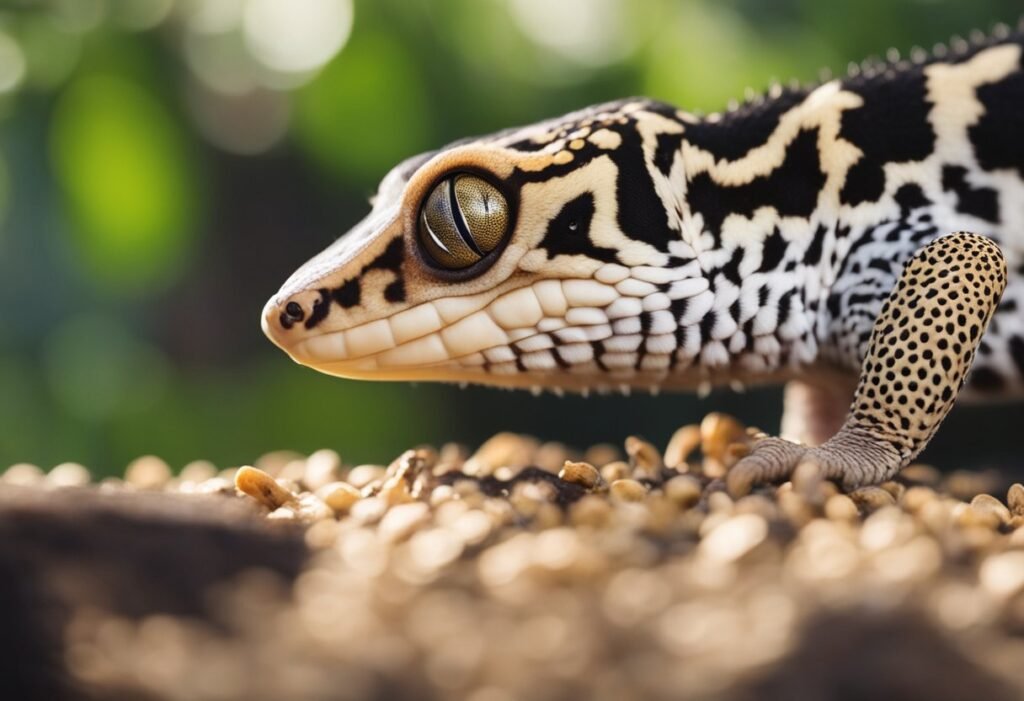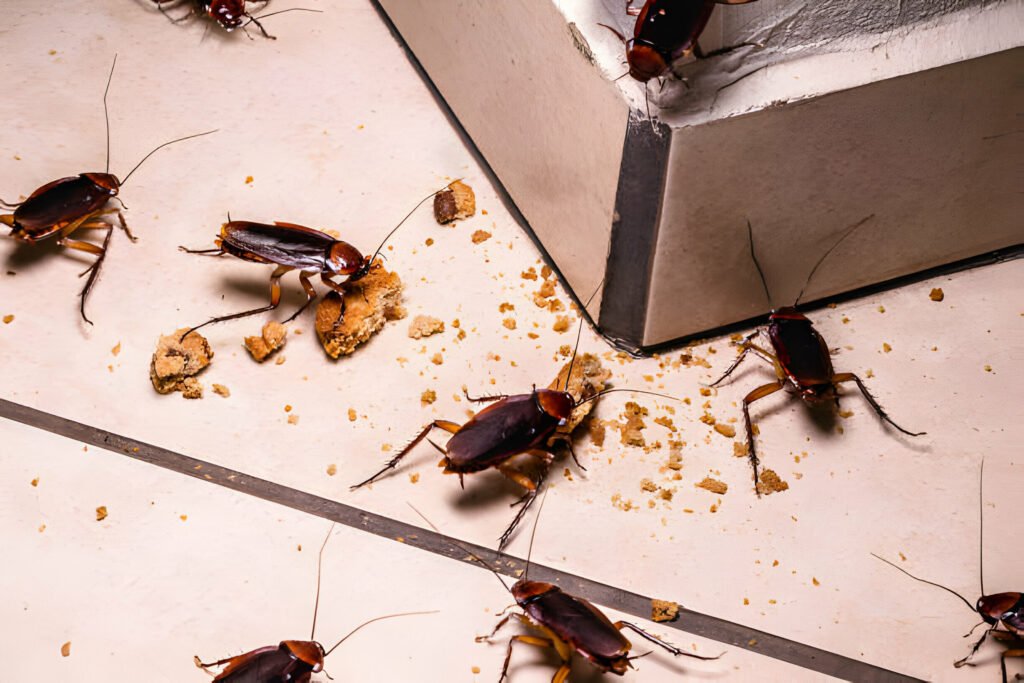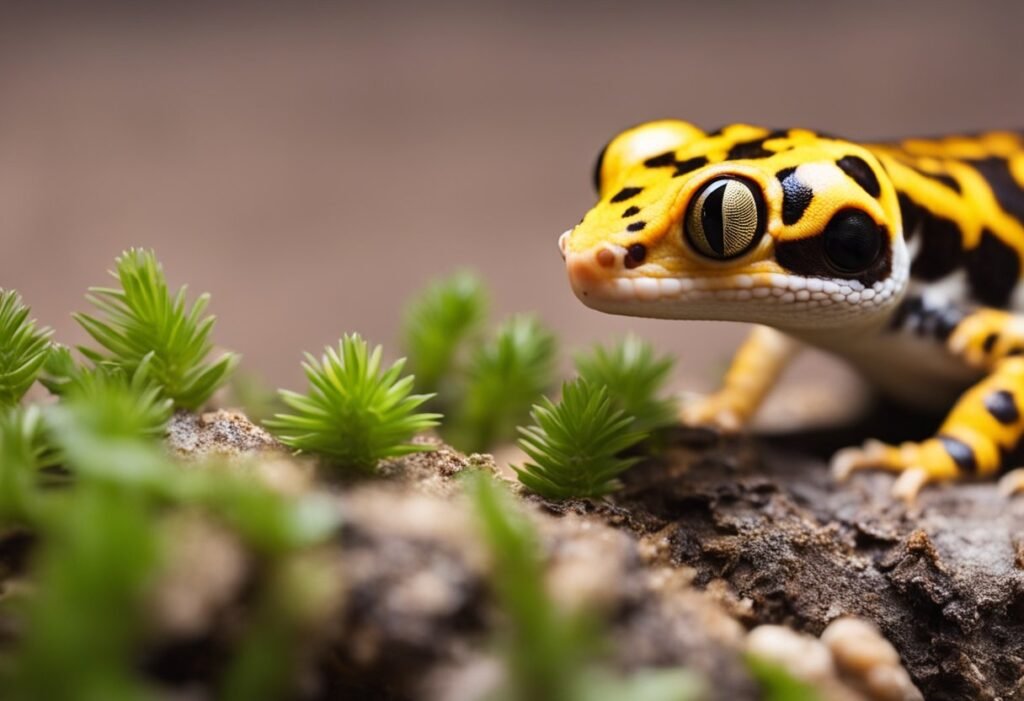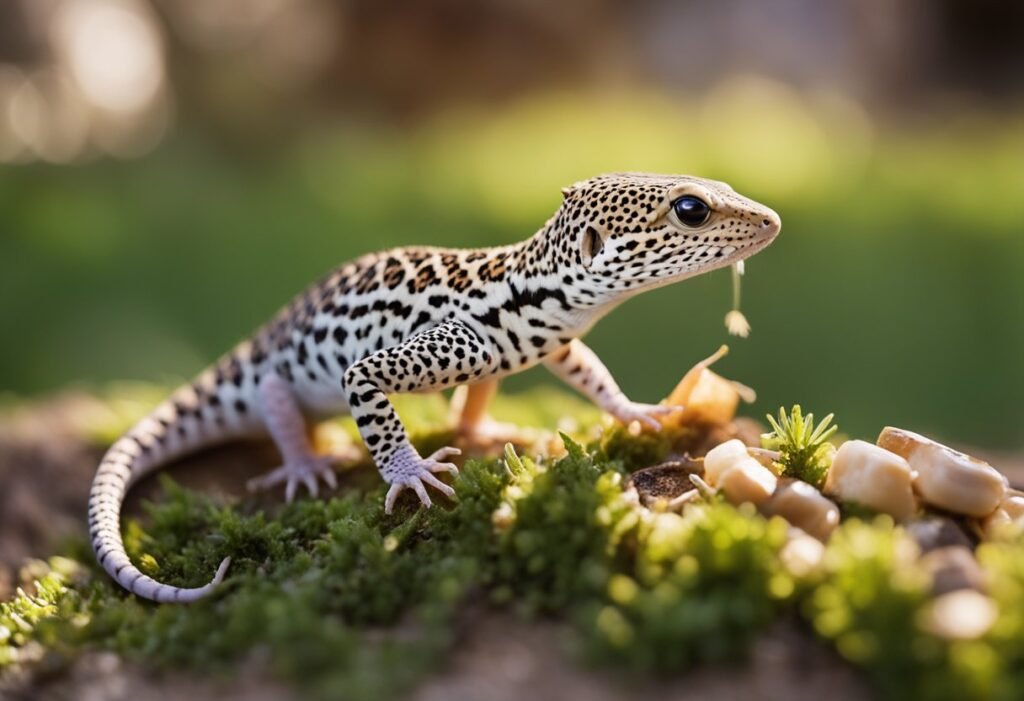Leopard geckos are a popular pet for reptile enthusiasts due to their unique appearance and easy-to-care-for nature. As with any pet, it’s important to provide them with a balanced and nutritious diet. Many owners wonder if it’s safe to feed their leopard geckos house roaches, which are commonly found in households.
The short answer is yes, leopard geckos can eat house roaches. In fact, some owners even choose to breed their own roaches as a cost-effective and sustainable food source for their geckos. However, it’s important to ensure that the roaches are free from any harmful chemicals or pesticides that could harm your pet. In this article, we’ll explore the benefits and potential risks of feeding your leopard gecko house roaches and provide tips on how to safely incorporate them into their diet.
Dietary Basics for Leopard Geckos

Leopard geckos are insectivores, which means they eat insects as their primary source of nutrition. In the wild, they feed on a variety of insects, including crickets, mealworms, and waxworms. As pets, they can also be fed a variety of insects, as well as commercially available gecko food.
When feeding your leopard gecko, it is important to ensure that the food is appropriately sized. The insects should be no larger than the width of the gecko’s head. Feeding your gecko food that is too large can cause digestive problems and even lead to impaction.
It is also important to provide a variety of insects to ensure that your gecko receives a balanced diet. Feeding only one type of insect can lead to nutritional deficiencies.
In addition to insects, it is important to provide your leopard gecko with a calcium supplement. Calcium is essential for healthy bones and proper muscle function. A lack of calcium can lead to metabolic bone disease, a serious condition that can be fatal.
Overall, a balanced diet is essential for the health and well-being of your leopard gecko. By providing a variety of appropriately sized insects and a calcium supplement, you can help ensure that your gecko receives the nutrition it needs to thrive.
Safety of House Roaches as Food

When it comes to feeding leopard geckos, many owners wonder if house roaches are a safe and nutritious food source. While house roaches can be a suitable food option for leopard geckos, there are some important things to consider before adding them to your pet’s diet.
Firstly, it’s important to ensure that the house roaches you are feeding your leopard gecko are not contaminated with pesticides or other harmful chemicals. It’s recommended that you either breed your own roaches or purchase them from a reputable supplier to ensure their safety.
Additionally, it’s important to note that some leopard geckos may be allergic to roaches, just as some humans are allergic to certain foods. If you notice any signs of an allergic reaction, such as swelling or difficulty breathing, discontinue feeding your leopard gecko roaches and consult with a veterinarian.
Overall, house roaches can be a safe and nutritious food option for leopard geckos as long as proper precautions are taken. As with any new food item, it’s important to introduce roaches slowly and monitor your pet’s reaction to ensure their health and well-being.
Nutritional Value of House Roaches
When considering feeding house roaches to leopard geckos, it is important to understand their nutritional value. House roaches are a good source of protein and fat, which are essential components of a leopard gecko’s diet.
One of the main benefits of feeding house roaches to leopard geckos is their high protein content. Protein is essential for growth and development, as well as for maintaining muscle mass and overall health. House roaches also contain a significant amount of fat, which is important for providing energy to the gecko.
In addition to protein and fat, house roaches also contain a variety of vitamins and minerals that are important for leopard gecko health. Some of the key vitamins and minerals found in house roaches include calcium, phosphorus, and vitamin B12. These nutrients are important for bone health, metabolism, and overall wellbeing.
Overall, house roaches can be a nutritious addition to a leopard gecko’s diet. It is important to ensure that they are fed in moderation, however, as too much fat can lead to obesity and other health problems. Additionally, it is important to ensure that the house roaches are free from any harmful pesticides or other contaminants that could be harmful to the gecko.
Preparing House Roaches for Feeding

When it comes to feeding leopard geckos, house roaches are a great option. They are nutritious, easy to find, and can be easily prepared for feeding. Here are some steps to follow when preparing house roaches for your leopard gecko:
- Purchase healthy house roaches from a reputable source. Avoid using roaches that have been exposed to pesticides or other harmful chemicals.
- Keep the roaches in a separate container with food and water for at least 24 hours before feeding them to your leopard gecko. This will ensure that they are well-nourished and hydrated.
- Prior to feeding, remove any uneaten food or debris from the roach container. This will prevent your leopard gecko from ingesting any unwanted substances.
- If the house roaches are too large for your leopard gecko to eat, you can cut them into smaller pieces using scissors or a sharp knife. Be sure to cut the roaches into bite-sized pieces to avoid choking hazards.
- Finally, offer the prepared house roaches to your leopard gecko using feeding tongs. This will prevent your gecko from accidentally biting your fingers.
By following these steps, you can ensure that your leopard gecko is getting a healthy and nutritious meal from house roaches.
Feeding Frequency and Portion Size
When it comes to feeding leopard geckos, it’s important to ensure that they receive the right amount of food at the right frequency. Overfeeding or underfeeding can lead to health problems, so it’s crucial to get it right.
In terms of feeding frequency, we recommend feeding adult leopard geckos every two to three days. Juvenile leopard geckos should be fed more frequently, as they are still growing and require more sustenance. We suggest feeding them every day or every other day.
When it comes to portion size, it’s important to take into account the size of your leopard gecko. As a general rule, the prey item should be no larger than the width of your gecko’s head. This ensures that they can swallow it comfortably and without risk of choking.
We recommend feeding them a variety of prey items, including crickets, mealworms, and dubia roaches. It’s important to provide a balanced diet that includes both protein and calcium-rich foods.
To ensure that your leopard gecko is getting the right amount of food, we suggest keeping track of their feeding schedule and portion sizes. This can help you identify any potential issues and adjust their diet accordingly.
In summary, feeding frequency and portion size are crucial factors to consider when feeding leopard geckos. By providing a balanced diet and monitoring their intake, you can ensure that your gecko stays healthy and happy.
Alternative Food Options for Leopard Geckos
As responsible pet owners, we understand the importance of providing our leopard geckos with a well-balanced diet. While insects such as crickets and mealworms are the primary food sources for these reptiles, there are alternative food options that can be included in their diet.
- Dubia Roaches – These roaches are a popular alternative to crickets and are high in protein. They are also low in fat, making them a healthy option for leopard geckos. Dubia roaches are easy to breed and can be purchased online or at pet stores.
- Silkworms – Silkworms are another great alternative to crickets and are high in protein and calcium. They are also low in fat and can be purchased online or at some pet stores.
- Waxworms – Waxworms are high in fat and should only be given as an occasional treat. They are a good source of calcium and can be purchased at some pet stores.
- Superworms – Superworms are high in protein and are a good source of calcium. They are also low in fat and can be purchased at some pet stores.
It is important to note that while these alternative food options can be included in a leopard gecko’s diet, they should not replace their primary food source of crickets or mealworms. It is also important to provide a variety of food options to ensure that your leopard gecko is receiving a well-balanced diet.
Overall, incorporating alternative food options into your leopard gecko’s diet can provide them with additional nutrients and variety. Always do your research and consult with a veterinarian if you have any concerns about your leopard gecko’s diet.
Signs of a Healthy Diet in Leopard Geckos
A healthy diet is essential for the well-being of leopard geckos. Here are some signs that indicate your leopard gecko is getting a healthy diet:
1. Proper Weight
Leopard geckos should have a healthy weight, not too thin or too overweight. A healthy leopard gecko should have a plump tail and a rounded belly. If your leopard gecko is underweight or overweight, it may indicate an unhealthy diet.
2. Regular Bowel Movements
Leopard geckos should have regular bowel movements. The feces should be firm, well-formed, and not too runny or too hard. If your leopard gecko is not having regular bowel movements, it may indicate an unhealthy diet.
3. Bright and Clear Eyes
Leopard geckos should have bright and clear eyes. If the eyes are dull or cloudy, it may indicate a nutritional deficiency or illness.
4. Shedding Properly
Leopard geckos should shed their skin properly. If the skin is not shedding properly, it may indicate a nutritional deficiency or illness.
5. Active and Alert
Leopard geckos should be active and alert. If your leopard gecko is lethargic or inactive, it may indicate an unhealthy diet.
In conclusion, a healthy diet is crucial for the well-being of leopard geckos. By ensuring that your leopard gecko has a balanced and nutritious diet, you can help them live a happy and healthy life.
Risks and Considerations
When considering feeding house roaches to leopard geckos, there are a few risks and considerations to keep in mind.
Firstly, house roaches may have been exposed to pesticides or other chemicals that could be harmful to your gecko. It’s important to ensure that the roaches you are feeding are from a safe and reliable source.
Additionally, house roaches may carry diseases or parasites that could be transmitted to your gecko. It’s important to properly clean and quarantine any roaches before feeding them to your gecko.
Feeding house roaches exclusively may also lead to an unbalanced diet for your gecko. While they can provide a good source of protein, they should be supplemented with other food items such as crickets, mealworms, and waxworms.
Finally, it’s important to monitor your gecko’s behavior and health after feeding them house roaches. If you notice any adverse reactions or changes in behavior, it may be best to discontinue feeding them house roaches.
Overall, while house roaches can be a suitable food source for leopard geckos, it’s important to take these risks and considerations into account before incorporating them into your gecko’s diet.
Monitoring Your Leopard Gecko’s Health

As responsible pet owners, we must monitor our leopard gecko’s health regularly. This includes observing their behavior, appearance, and feeding habits. In this section, we will discuss some key indicators that can help us determine if our leopard gecko is healthy.
Behavior
Leopard geckos are generally active at night and tend to sleep during the day. If we notice a sudden change in their behavior, such as lethargy or lack of appetite, it could be a sign of illness. We should also keep an eye out for any unusual movements or behaviors, such as shaking, twitching, or stumbling.
Appearance
A leopard gecko’s appearance can also indicate their overall health. We should check their skin for any abnormalities, such as cuts, bruises, or discoloration. A healthy leopard gecko should have clear eyes, a plump tail, and a well-rounded body shape. If we notice any changes in their appearance, we should consult a veterinarian.
Feeding Habits
Leopard geckos are carnivores and require a diet that consists mainly of insects. We should monitor their feeding habits and ensure they are eating enough. If our leopard gecko is refusing food or eating less than usual, it could be a sign of illness. We should also make sure they are getting a variety of insects to ensure they are receiving all the necessary nutrients.
In conclusion, monitoring our leopard gecko’s health is essential to ensure they live a long and healthy life. By observing their behavior, appearance, and feeding habits, we can detect any potential health issues early on and seek appropriate treatment.
Frequently Asked Questions
Are house roaches safe for leopard geckos to consume?
Yes, house roaches are safe for leopard geckos to consume as long as they are not exposed to pesticides or other harmful chemicals. It is important to ensure that the roaches are gut-loaded and dusted with calcium and other necessary supplements before feeding them to your leopard gecko.
What insects are suitable for a leopard gecko’s diet?
Leopard geckos are insectivores and require a diet consisting of insects such as crickets, mealworms, waxworms, and roaches. It is important to ensure that the insects are appropriately sized for your leopard gecko and are gut-loaded and dusted with necessary supplements.
Can feeding wild insects to leopard geckos pose health risks?
Yes, feeding wild insects to leopard geckos can pose health risks as they may contain harmful parasites or diseases. It is recommended to purchase insects from a reputable source or breed them yourself to ensure their safety.
How can you safely incorporate roaches into a leopard gecko’s diet?
To safely incorporate roaches into a leopard gecko’s diet, ensure that the roaches are gut-loaded and dusted with necessary supplements. It is also important to monitor your leopard gecko’s consumption and adjust the feeding schedule accordingly.
What are the nutritional benefits of roaches for leopard geckos?
Roaches are a good source of protein and calcium for leopard geckos. They also contain other important nutrients such as vitamins and minerals that are necessary for their overall health.
How does the presence of lizards affect cockroach populations indoors?
The presence of lizards such as leopard geckos can help control cockroach populations indoors. However, it is important to ensure that the lizards are properly cared for and their diet is supplemented with other necessary nutrients to prevent overconsumption of roaches.





